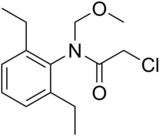Alachlor
 |
|
 |
|
| Names | |
|---|---|
|
IUPAC name
2-Chloro-N-(2,6-diethylphenyl)-N-(methoxymethyl)acetamide
|
|
| Identifiers | |
|
3D model (Jmol)
|
|
| ChEBI | |
| ChemSpider | |
| ECHA InfoCard | 100.036.448 |
| KEGG | |
|
PubChem CID
|
|
| UNII | |
|
|
|
|
| Properties | |
| C14H20ClNO2 | |
| Molar mass | 269.767 g/mol |
| Density | 1.12 g/mL |
|
Except where otherwise noted, data are given for materials in their standard state (at 25 °C [77 °F], 100 kPa).
|
|
|
|
|
| Infobox references | |
Alachlor is an herbicide from the chloroacetanilide family. It is an odorless, white solid. The greatest use of alachlor is for control of annual grasses and broadleaf weeds in crops. It is the second most widely used herbicide in the United States. Use of alachlor as a herbicide is banned in the European Union.
Its mode of action is elongase inhibition, and inhibition of geranylgeranyl pyrophosphate (GGPP) cyclisation enzymes, part of the gibberellin pathway. It is marketed under the trade names Alanex, Bronco, Cannon, Crop Star, Intrro, Lariat, Lasso, Micro-Tech and Partner.
The largest use of alachlor is as a herbicide for control of annual grasses and broadleaf weeds in crops, primarily on corn, sorghum, and soybeans. It is the second most widely used herbicide in the United States, with particularly heavy use on corn and soybeans in Illinois, Indiana, Iowa, Minnesota, Nebraska, Ohio and Wisconsin.
Alachlor mixes well with other herbicides. It is marketed in mixed formulations with atrazine, glyphosate, trifluralin and imazaquin. It is a selective, systemic herbicide, absorbed by germinating shoots and by roots. Its mode of action is elongase inhibition, and inhibition of geranylgeranyl pyrophosphate (GGPP) cyclisation enzymes, part of the gibberellin pathway. Stated more simply, it works by interfering with a plant's ability to produce protein and by interfering with root growth.
It is most commonly available as microgranules containing 15% active ingredients (AI), or emulsifiable concentrate containing 480 g/ litre of AI. Homologuation in Europe requires a maximum dose of 2,400 g per hectare of AI, or 5 litres/hectare of emulsifiable concentrate or 17 kg/ha of microgranules. The products are applied as either pre-drilling, soil incorporated or pre-emergence.
...
Wikipedia
